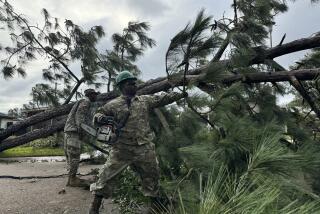In New Orleans, at least this doctor is in
NEW ORLEANS — “Doctor’s Office Open,” declares a blue and white banner hanging from trees in front of the white brick building where Robert Travis Kenny practices medicine.
It’s not a sign you would normally see in the decorous world of medicine, but in post-Katrina New Orleans, an open doctor’s office actively seeking patients is noteworthy. In the Mid-City neighborhood, where Kenny’s office is, only five doctors remain of the 120 he estimates were in practice before the August 2005 hurricane.
Residents are returning to New Orleans faster than healthcare workers. The shortage of doctors -- on top of fewer and overcrowded hospitals, lost or destroyed medical records, and delays in everything from getting an appointment to lab test results -- has contributed to a sense that medical care here is still not recovering.
Lindy Boggs Medical Center, where Kenny used to be president of staff, remains closed, along with six of the eight acute care facilities that once operated in Orleans Parish. Before Katrina, there were 2,269 beds for acute care patients at the parish’s hospitals; today, there are 635, according to the Louisiana Department of Health and Hospitals.
“I question why people with medical problems would return,” said Kenny, 58. “Until you have enough hospital beds and the system gets up and running, it’s a dangerous place to live for unhealthy people.”
Vernon Rapp, 68, who was referred to Kenny by a pharmacist, is a grateful new patient. The doctor who kept Rapp’s medical records moved to Covington, La., after the hurricane. Another doctor he had seen for more than 10 years simply disappeared, Rapp says. The surgeon who performed Rapp’s knee replacement and his neurologist left the area after the Methodist Hospital, where they practiced, did not reopen after the storm.
Kenny, like other doctors here who stayed or have returned, now copes with more patients -- the majority of them new -- longer hours and limited support personnel at the hospital where he is on staff.
Doctors say there has been an influx of patients with Katrina-related ailments. Kenny said he was seeing an increase in chronic coughing, often caused by the inhalation of particles during home renovation, and depression.
“Depression is what is most overwhelming in New Orleans,” Kenny said. “You’re dealing with the government that is horribly slow [in disbursing aid]. You’re dealing with contractors who are sometimes liars and cheats. You’re dealing with loans.”
When Kenny returned to New Orleans three weeks after Katrina, he found the equipment and furniture in his ground-floor office caked with mud. Three feet of flooding left patient files and documents a soggy mess. Kenny and his staff carefully pulled them apart and laid the salvageable pages out to dry.
It took two days to strip the interior of the building, which has second-floor rental units; three weeks to get the air conditioner up and running; and four months for the roof to be repaired. Kenny, whose hobby is renovation, did much of the work himself.
Less than a month after the storm, he started seeing three or four patients a day, using the upstairs apartments as exam rooms.
“I was worried at first that I had made a mistake” coming back, said Kenny, who used to see several generations of families.
He telephoned former patients, but nine out of 10 could not be reached. He put a notice in the local newspaper declaring he was back. He left business cards at the only two local drugstores still open.
Kenny’s patient population soon exploded, and a significant number were walk-ins.
Across the river on the city’s West Bank, Dr. Alix Bouchette started picking up the pieces of his practice about two weeks after the storm.
Bouchette thought it would take three months to get his office renovated; it took a year and a half.
“The biggest challenge is the influx of new patients and the burden new patients are putting on you,” said Bouchette, 51.
Like most other doctors who have returned, Bouchette has inherited scores of patients for whom he has no medical records. Most of his new patients are uninsured. Many are elderly and on Medicaid. Some can’t remember which medicines they were taking before the storm.
“They have to bring in all their medication, and we start from scratch,” Bouchette said.
Before Katrina, uninsured patients would typically have been treated at Charity Hospital of New Orleans. But that facility closed, sending uninsured and Medicaid patients into the private doctors’ offices and the emergency rooms of the few remaining hospitals.
This can cause a strain, because “primary care is so much about relationships and knowledge of the person, and comfort in the relationship,” said Dr. Richard Streiffer, chairman of the department of family and community medicine at Tulane University School of Medicine. “It takes time to redevelop that.”
Bouchette, who is on staff at Ochsner Medical Center, said that before Katrina, he would typically treat one or two emergency room patients while on call. Today, it’s eight to 15.
His workday used to end at 6 p.m., but now he is lucky if he gets home before 11. “You have less time for yourself and your family,” Bouchette said.
And there is a new dynamic between doctors and patients.
“The whole nature of the encounter between doctor and patient has changed,” Streiffer said. “Before, it was just ‘Why are you here today?’ Now it is ‘How did you make out? Where’ve you been?’
“And you’ve got to listen to people’s stories. It really doesn’t fit into a 15-minute visit.
“So much of the primary health visit is couched in mental health concerns.”
And with life’s general challenges more acute since Katrina, the added stress of work is getting to many doctors, Streiffer said.
Other doctors said they had had little choice but to shut down their practices after the hurricane.
Flooding destroyed both of the offices of family practitioner Dr. Bong Mui -- one in New Orleans East, the other in Chalmette. Mui’s home was also ravaged, as was a day spa his wife operated.
The couple’s livelihood was essentially wiped out.
“Without a place to stay, there was no way we would be able to go back and think about building. It would take years,” said Mui, 60, who had been practicing in New Orleans for almost three decades. A large portion of his patient population disappeared because of Katrina, as did his records.
Mui relocated to Houston, where he has friends and family.
“It was very sad,” Mui said. “I had been living in New Orleans for 31 years. But what can I do?”
His medical partner of 20 years opened a new office in Slidell, La. A junior associate of three years moved to Austin, Texas. Mui sold his eastern New Orleans practice but hasn’t decided what to do with his gutted house and the office in Chalmette.
It took a year for Mui to get a license to practice in Texas.
His annual earnings have dropped from about $500,000 before Katrina to $140,000.
But Mui has decided to make a life in Houston, which has a flourishing Vietnamese American community.
“It fits me here,” said Mui, a Vietnamese native who paints and writes poetry as a hobby. “I can do a lot culturally. I think I’m pretty happy here right now. But every time I look back to New Orleans, I feel terrible.”
In an effort to lure healthcare professionals, Louisiana is to receive a $15-million federal grant to provide up to $110,000 in incentive payments to primary care doctors and other healthcare workers who move to New Orleans or surrounding areas.
Kristy Nichols, director of the Louisiana Department of Health and Hospitals’ Bureau of Primary Care and Rural Health, cited a particular demand for doctors who could specifically treat uninsured or Medicaid patients. She also cited a need to better inform such patients where to seek treatment and how to pay for it.
Streiffer, of Tulane University, said medical facilities also needed a large dose of cash to help pay for the uncompensated care they gave to uninsured and Medicaid patients.
“Financially all the hospitals are bleeding and going into reserve, and they can’t sustain that forever,” Streiffer said.
More to Read
Sign up for Essential California
The most important California stories and recommendations in your inbox every morning.
You may occasionally receive promotional content from the Los Angeles Times.











